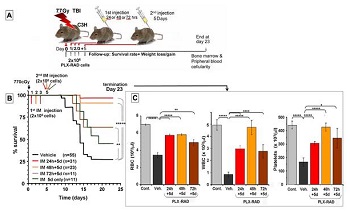
![pluristem_logo[1]](http://v2023.hadassahinternational.org/wp-content/uploads/2015/04/pluristem_logo1.jpg) Placental cells, Hadassah University medical Center researchers have shown, were successful in mitigating acute radiation-induced complications in mice when transplantation was initiated 24 hours following total body irradiation.
Placental cells, Hadassah University medical Center researchers have shown, were successful in mitigating acute radiation-induced complications in mice when transplantation was initiated 24 hours following total body irradiation.
The research team from Hadassah’s Biotechnology and Radiobiology Laboratory at the Sharett Institute of Oncology studies two types of placental calls—pure maternal cell preparations (PLX-Mat) and a mixture of maternal and fetal derived cells (PLX-RAD), developed by Pluristem Therapeutics, a leading developer of placenta-based cell therapies. Using intramuscular (IM) injections, they were able to overcome the difficulty experienced by other researchers whereby, with intravenous treatment, the stem cells became trapped mostly in the lungs immediately after administration. Rather, IM injections enabled them to easily deliver higher numbers of cells through multiple injections at different times.
Twenty four hours and five days after total body irradiation, the mice were treated with placental stromal cells (PLX). The researchers discovered that PLX-Mat increased the survival of the irradiation mice from 27 to 68 percent, while PLX-RAD cells increased the survival to 98 percent. The researchers found that they could delay the treatment with PLX-RAD up to 48 hours after irradiation with similar success. The study showed that the treated Mice regained their weight significantly faster than did the few control survivors. Furthermore, the treatment stimulated extensive hematopoietic (blood producing) stem cell proliferation, which enabled the speed recovery of the radiation-induced depleted bone marrow with a parallel increase in the number of circulation white blood cells, red blood cells, and platelets.
The authors conclude: “Our study suggests that IM treatment with PLX-RAD cells may serve as a highly effective ‘off the shelf’ therapy to treat bone marrow failure following total body exposure to high doses of radiation.” These cells can be stored, delivered frozen, and then defrosted just before injection.
The researchers add that they expect the treatment may also have major applications for clinical conditions associated with severe bone marrow aplasia, where blood cell development is impaired.
These research findings appear in the June 18th issue of the professional online journal, PLOS One. For the full article, entitled “Mitigation of Lethal Radiation Syndrome in Mice by Intramuscular Injection of 3D Cultured Adherent Human Placental Stromal Cells,” see http://www.plosone.org/article/info%3Adoi%2F10.1371%2Fjournal.pone.0066549
